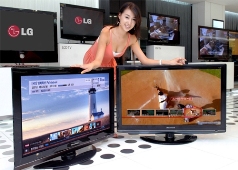 From Google to Samsung, electronics and technology players are betting on web content delivered directly to TV sets.
From Google to Samsung, electronics and technology players are betting on web content delivered directly to TV sets.
Your idiot box is getting smarter fast. Consider this: You can now surf the web, download videos from YouTube, stream games from websites and even download news and traffic updates for a quick take on what's happening around you.
Web-connected LCD TVs can switch seamlessly from web to TV viewing, with a high-speed broadband connection that hooks to the TV instead of the household PC. But all this comes at a hefty price -- anything between Rs 60,000 and Rs 4 lakh.
For record, Anil Ambani has reportedly bought a couple of top-end LED TVs that can wirelessly connect with mobile devices allowing movies, photos and music sharing, stream apps from internet and can even connect to social networking sites.
Earlier this month, Apple CEO Steve Jobs unveiled a web-to-TV platform that hooks on to TVs and costs $99. Apple TV allows viewers to stream shows and movies that they have rented or downloaded from iTunes and can access YouTube, Flickr and other websites as well.
TV screens of tomorrow
Already, TV manufacturers have kind of ditched the "3D with glasses" thing and are betting on web access, app stores and other connected features that enhance the viewing process. Samsung India Deputy Managing Director Ravinder Zutshi underlines that 3D TVs may be hogging the limelight but the real revolution is that televisions are getting smarter. With built-in Ethernet connection and wireless-ready capabilities, Samsung is betting big on its latest line-up of web-connected 3D TVs.
The electronics major has upgraded 'Internet@TV' feature to include Samsung Apps from leading services like Associated Press, Blockbuster, Fashion TV, Twitter, Netflix and YouTube, among others.
"Web apps on TVs will be the biggest change in the TV experience," claims Zutshi.
Google CEO Eric Schmidt, during his keynote session at the IFA technology show in Berlin, demonstrated a seamless transition from watching TV to browsing the Internet on a Sony Bravia TV. Google TV would go live in the US this year and would launch worldwide next year.
Back home, Samsung claims that sales of internet-connected TV sets that are also capable of 3D visuals have multiplied. "We will sell over 30,000 3D TVs in India this year, and these 3D LED TVs have capability to connect to the internet," adds Zutshi.
Make way for TV apps
Manufacturers such as Sony and Logitech are also working with Google to integrate video-on-demand services on Google TV. Google also plans to open source the Google TV platform so that developers can benefit from the project.
"The long-term goal is to collaborate with the entire developer community to help drive entertainment in the living room forward and to introduce the next generation of TV-watching experience," said Google in an official release.
Google's Android platform will also be integrated with Google TV, enabling the use of smartphones, voice commands to change channels and even get Android apps on TVs.
Sony's Bravia NX series -- which comes with a built-in WiFi that gives on-demand internet content such as YouTube video clips, websites like DailyMotion, Blip.TV, MenStyle, Wired, GolfLink, eHow, Livestrong, among others -- has found takers in India, according to Tadato Kimura, general manager, marketing, Sony India.
"Bravia internet widgets give users configurable and customisable add-ons to news, weather and all sorts of information. Looking forward, we see a huge demand for Internet-enabled televisions," he says.
The future
Home-grown players like Mirc Electronics, which also owns brand Onida, agree that India has the potential "for a single-product offering to integrate the set-top box, the DVD player, the web connection and the content storage device."
K Sriram, vice-president (marketing, sales and services), confirms: "We already have web-capability technology available, we are focusing on the high-end LCD and LED TV space to deliver this feature. We are open to work with integrators and content providers on specific platforms."
He adds that a comprehensive TV experience, coupled with web surfing, emailing, net telephony, video chatting and content downloads, would work the best for Indian consumers.
Should there be any doubt about the importance of the web to television, Panasonic also joins the bandwagon by offering 3D movies on demand, direct to customers with new TVs that support 'Vieracast' web system and who have a broadband connection able to cope with enormous files.
Manish Sharma, director, marketing, Panasonic India, says: "We have already launched Panasonic V series plasma television which supports such web-based applications. The product has been in good demand in major metro markets."
The problem that haunts Indian consumers is the lack of availability of broadband or wireless connectivity. "The ecosystem required to make internet TVs a success is high-speed Internet connectivity and quality content," highlights Rohit Pandit, home entertainment head of LG India.
He, however, adds: "It's a new platform on which content providers will reach home consumers with both general and exclusive content and the benefit to the consumer is the freedom to access."
There's no denying that consumers' interaction with their televisions is about to undergo an alteration.
There would be live streaming of HD videos from the web, personal photo viewing from mobile devices, interacting with friends and playing casual games online -- and all this will happen at the push of a button on their remote controls.







 © 2025
© 2025